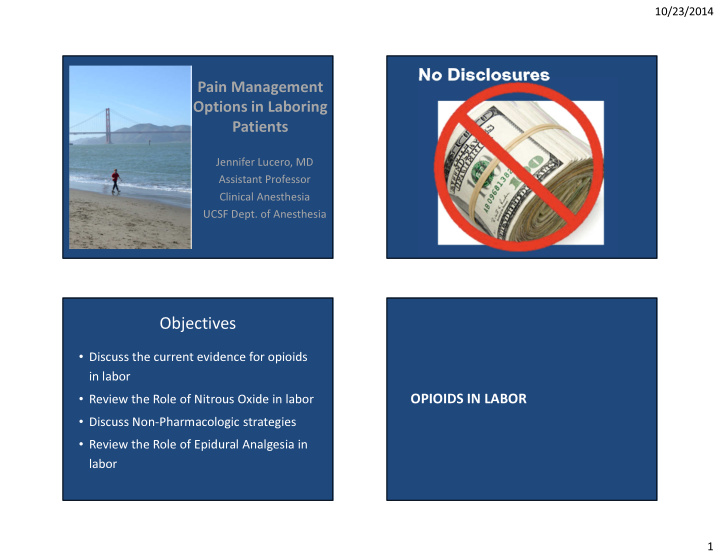



10/23/2014 Pain Management Options in Laboring Patients Jennifer Lucero, MD Assistant Professor Clinical Anesthesia UCSF Dept. of Anesthesia Objectives • Discuss the current evidence for opioids in labor • Review the Role of Nitrous Oxide in labor OPIOIDS IN LABOR • Discuss Non-Pharmacologic strategies • Review the Role of Epidural Analgesia in labor 1
10/23/2014 Remifentanil Pharmacokinetics: Fentanyl Pharmacokinetics Ultra-Short Acting ( mu-1 opioid receptor agonist) • Short acting synthetic μ-1 & μ-2 opioid • Rapid onset (onset = 30-60 sec; Peak = 2.5 min) receptor agonist • Rapid onset of action in 30-60 sec • Inactive metabolites (plasma esterases) • Peak analgesic effect within 2.5 min • “ “ “ “ Respiratory Depression ” ” ” ” half-life (2.5 min) • Cumulative effect with repeated or prolonged • Short Context-Sensitive half-life (3.5 min) administration • Increased context sensitive half-life: ≈70 min Hinova et al. Systemic Remifentanil for Labor Analgesia. Anesthesia & Analgesia . 2009; 109(6): 1925-9. • Elimination in neonates varies: 75-440 min Babenco et al. The pharmacodynamic effect of a remifentanil bolus on ventilatory control. Anesthesiology 2000; 92:393-8. Maternal-Fetal Transfer Remifentanil and Pregnancy • The placenta contains nonspecific esterases • Fetal esterases nearly fully developed at birth • Within 5-10 minutes of turning off an infusion there is virtually no residual effect. • Remifentanil can be turned off minutes before delivery without fetal respiratory depression Kan, R, et al.. Anesthesiology; 1998;88:1467-74 2
10/23/2014 Maternal-Fetal Transfer * Douma et al. Br J Anesth 2010; 104(2): 209-15. Kan, R, et al.. Anesthesiology; 1998;88:1467-74 RCT Remifentanil vs. Epidural Meperidine Fentanyl Remifentanil Satisfaction 7.0 7.3 8.1* Epidural 34% 15%* 13%* N=45 Total Supp O 2 8% 2% 12% Sat < 95% 33% 56%* 74%* Apgar 1 8.6 8.5 8.9 Apgar 5 9.7 9.6 9.9 Volmanen et al. Acta Anesthesiol Scand 2008; 52: 249-55. * = p<.05 vs. Demerol Douma et al. Br J Anesth 2010; 104(2): 209-15. 3
10/23/2014 4
10/23/2014 • Remifentanil Group: transient maternal desaturation observed more frequently • Fentanyl Group: larger number of neonates NITROUS IN LABOR required resuscitation • Pain scores were no different between the groups Nitrous oxide Patients: 11% Complete 61% Considerable 28% Slight or None Midwives: 7% Excellent 35% Good 49% Adequate 9% inadequate Rosen 1969 BMJ, Vol3:263 5
10/23/2014 • 58 publications reviewed – 2 studies good quality – 11 studies fair – 46 studies poor • Nitrous less effective pain relief than epidural • Heterogeneous outcomes for satisfaction • No difference in neonatal outcomes • More good quality studies needed Coping Algorithm vs. Pain Scores in Labor • Developed to provide an alternative pain scores • Formalized assessment tool for laboring women • Future Research – Validation with different cultures ethnicities – Validation from patient perspective – Generalizability at other institutions 6
10/23/2014 7
10/23/2014 NON-PHARMACOLOGIC METHODS Listening to Mothers- 2006 • Survey of women who gave birth in a hospital in 2005 • 1,573 survey participants • Ages 18-45 • Only single gestations (multiple gestations excluded) 8
10/23/2014 Historically, a Bad Reputation Thorp, JA et al .The effect of continuous epidural analgesia on cesarean section for dystocia in nulliparous women. Am J Obstet Gynecol. 1989; 161(3): 670-5 EPIDURAL ANALGESIA Thorp, JA et al.Epidural analgesia and cesarean section for dystocia : risk factors in nulliparas. Am J perinatology1991;8 (6):402-410 Thorp, JA et al. The effect of Intrapartum Epidural Analgesia on Nulliparous Labor: Randomized, Controlled, Prospective Trial. Am J Obstet Gynecol 1993 196(4):851-858. 9
10/23/2014 Outcome Narcotic (45) Epidural (48) Oxytocin Augmentation 26.7% 58.3% Head Malposition 4.4% 18.8% Assisted Vaginal Delivery 11.1% 18.8% Cesarean Delivery 2.2% 25.0% …when feasible, obstetric practitioners should delay the administration of epidural analgesia in nulliparous women until cervical dilatation reaches Thorp, JA et al. The effect of Intrapartum Epidural Analgesia on 4–5 cm and other forms of analgesia be used until Nulliparous Labor: Randomized, Controlled, Prospective Trial. Am J Obstet Gynecol 1993 196(4):851-858. that time. Outcome Neuraxial Systemic P Value Cesarean 17.8 % 20.7% .31 Instrumental 19.6% 16.0% .13 Oxytocin 92.3% 94.5% .38 Neuraxial Duration 440 min 330 min .001 APGAR <7 (1min) 16.7% 24.0% .01 APGAR <7 (5min) 1.4% 2.5% .28 10
10/23/2014 E DIT O R S ’ C HO IC E E arly versus late initiation of epidural analgesia in labor: Does it increase the risk of cesarean section? A randomized trial American Journal of Obstetrics and Gynecology (2006) 194, 600–5 In the absence of a medical contraindication, maternal request is a sufficient medical indication for pain relief during labor…ACOG recognizes that many techniques are available for analgesia in laboring patients. None of the techniques appears to be associated with an increased risk of cesarean delivery. No increased risk of Cesarean Delivery or Instrumented Vaginal Delivery with early epidural placement 11
10/23/2014 Routine Epidural analgesia may be inferior to Epidural on Request leading to more Operative Deliveries: Vaginal and Cesarean Delivery 12
10/23/2014 It’s Complicated Labor dysfunction causes increased pain resulting in maternal request for epidural? Maybe OR Epidural causes increased second stage and operative vaginal delivery? Not Likely Complex interplay of Labor, Labor management, and epidural analgesia Labor epidural currently the most effective in reducing pain scores and producing most effective analgesia in labor Conclusions Conclusions • Opioids are safe for both mother and neonate • Pain scores should not be the only assessment of Labor analgesia • Remifentanil & Fentanyl PCA are alternative • There is a role of non-pharmacologic options options for women who epidural is in labor contraindicated • Epidurals do not increase your risk of • Nitrous Oxide has a role in labor analgesia operative deliveries • Epidural analgesia is best at maternal request and not as routine analgesia 13
10/23/2014 14
Recommend
More recommend